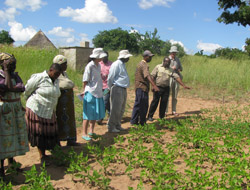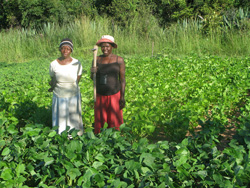Ken chose this article from a trip he made to Zimbabwe during the first phase of N2Africa which still triggers and intrigues him. In villages in Murewa, farmers were growing all four N2Africa target legumes - beans, cowpea, groundnut and soyabean for different markets in different niches… "I think this is a powerful line for investigation that we still have to explore that demonstrates the need for different seed systems and value chain approaches in the same village - thus bring us back again to a farming systems approach that I consider the foundation of N2Africa’s work". This article first appeared in Podcaster 12, January, February 2012.
I had the privilege of spending some time visiting delivery and dissemination (D&D) as well as research trials on agronomy and rhizbiology in Zimbabwe in February. The season started with difficulty in southern Africa, with a ‘false start’ to the season and then a three week dry period that led to failed early plantings of many crops and late planting periods for others. Nevertheless, there was a lot to see in the fields, and legumes suffer less from the late start to the season as they are mainly planted after the maize crop is established.
It was a real pleasure seeing the enthusiasm of N2Africa staff – I was in the field with N2Africa staff – Talkmore Mombeyarara (Agronomist), Isaac Chabata (Farm Liaison Officer), Judith de Wolf (M&E Specialist & Country Coordinator) – as well as with some of our important partners such as the Community Technology Development Trust (Patrick Kasasa), Agritex, and Prof Barbara Maasdorp from Crop Science, University of Zimbabwe who is leading the forages work for N2Africa in Zimbabwe. Some of you may remember that Barbara won the prize last year for naming the Podcaster! In many ways it was a trip down memory lane for me as I taught many of the NGO and N2Africa staff about legumes and nitrogen fixation together with Barbara when I was Prof of Soil Science in Zimbabwe. I also had a chance to visit Mazvita Murwira and other staff at SPRL who are in charge of rhizobiology research and oversee the inoculant production factory.
We saw some excellent trials and farmer-led demonstrations (see photos), and discussed what was going well, and what the problems were with farmers. The over-riding concern of farmers was access to inputs – such as certified seed, fertilizers, inoculants and credit facilities – as well as lack of ready markets for their produce. During the rich discussions in the field it became apparent that we need to be more reflexive in our thinking and more flexible regarding approaches in N2Africa.
 |
 |
| Patrick Kasasa of the Community Technology Development Trust discussing a sugar beans demonstration on the field visit | In the foreground you can see the response in soyabean using the SPRL inoculants produced in a D&D trial in Zimbabwe - behind the farmers Catherine Masenda and Annie Musakare is the uninoculated plot (Nhayungwa village, Goto, Hwedza) |
N2Africa started up with a fairly ‘top-down’ approach of training and demonstrations with lead farmers and then expansion to satellite farmers. The aim was also to drive a ‘value chain’ approach for the different crops, linking farmers to markets. This model can work well in some places with some crops, and is delivering successes in many countries, in particular with soyabean.
When we probed further about markets, not surprisingly we got different stories about the different crops, but stories that were consistent between the various farmer groups we visited. Indeed a value chain approach seems appropriate for soyabean with the main problem being one of consolidation of the grain harvest into loads for transport to markets – a market coordination issue.
For groundnut the challenges are similar in terms of consolidation of produce. But as opposed to soyabean which is only consumed in small quantities at household level, people know what to do with groundnuts. They consume them a lot and process them into peanut butter for sale at local level.
The situation was again different with sugar bean, as common bean or Phaseolus vulgaris is called in Zimbabwe. Some farmers were growing large fields of sugar bean targeted for a local market of missionary schools. Others complained of problems of keeping seed from one season to the next – not because of post-harvest pests – but because the beans are so popular they get eaten!! So there is generally little surplus, and that surplus can readily be sold through local markets. The other major issue for farmers growing beans is the poor performance in the coarse granite sands that are the predominant soils in most of the smallholder (communal) farming areas. Sugar beans only grow well in the ‘infields’ – the fields close to the homestead that receive regular dressings with cattle manure. But these fields are where the main ‘food-self-sufficiency’ crop of maize is grown. The farmers have the perfect solution – simply planting sugar beans as an intercrop without reducing the density of maize planting. The sugar beans generally grow well under maize and tend to produce more grain than when grown as sole crops.
What struck me particularly was the issue of markets for cowpea. Essentially, cowpea is grown by most farmers for their own consumption (both the grain and the leaves) and it is liked but not the most popular legume. In contrast with sugar beans, cowpea grows well on the coarse sandy outfields in Zimbabwe, if a little phosphorus can be applied. The varieties being offered by N2Africa are very popular with farmers and there is considerable demand for them locally. But apart from trade in seed of cowpea by some companies very little cowpea is sold on open markets, neither locally nor through the central grain markets in Harare. So cowpea is an important food-security legume for poor and wealthier farmers alike, and one where simply introducing the new varieties and ensuring their dissemination through local women’s groups can have an important impact at household level.
So where does this leave us? I think not with a problem but with an opportunity! We need simply to use differentiated models for the various legumes – a value chain approach for soyabean, a ‘mixed model’ for different varieties of groundnut, and different ‘local niche’ models for sugar bean and cowpea.
For me this is another example in a long line of experiences that demonstrate the importance of spending quality time discussing with farmers. Many seem to think that all of the good ideas come from farmers – and that may often be true – but in my mind it is the interaction between farmers, development agents and research that leads to innovation. Time to get your thinking hats on and to reflect on how best N2Africa can adapt to your local situations as I know many of you are doing already.
Thanks from me to all of those who gave up their valuable time to spend with me in the field.
And a plea to all you who read the N2Africa Podcaster – please share some of the rich experiences you have with us so that we can learn from each other to develop and test more diversified approaches to achieving our goals!
Ken Giller
